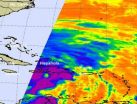(Press-News.org) NASA's Aqua satellite passed over Hurricane Sandy as it was moving over eastern Cuba early on Oct. 25. The AIRS instrument captured an infrared image of Sandy that showed a large area of very high, cold cloud tops indicating the power within the storm. Sandy is now headed toward the Bahamas and warnings and watches have already been posted for the mainland U.S.
The Atmospheric Infrared Sounder (AIRS) instrument aboard NASA's Aqua satellite captured infrared imagery of Hurricane Sandy's eastern half on Oct. 25 at 0559 UTC (1:59 a.m. EDT) that showed some strong thunderstorms around the eye of Sandy. Those thunderstorms are reaching high into the troposphere where cloud top temperatures are as cold as -63 Fahrenheit (-52 Celsius). In previous studies, those areas where the temperatures were that cold indicated heavy rainfall.
By 11 a.m. EDT on Oct. 25, the eye was no longer apparent in satellite imagery or from aircraft observations. Forecasters at the National Hurricane Center noted that Sandy "has become somewhat disrupted on the western side by southwesterly flow from an upper-level low to the west."
VIDEO:
An animation of NOAA's GOES-13 satellite observations from Oct. 23-25, 2012, show Hurricane Sandy move over Jamaica and cross over eastern Cuba. At 8 a.m. EDT on Oct. 25, 2012,...
Click here for more information.
Current Watches and Warnings
A Hurricane Warning is in effect for the Ragged Islands in the southeastern Bahamas, the Central Bahamas, the Northwestern Bahamas. A Tropical Storm Warning is in the effect for the Florida east coast from Ocean Reef to Flagler Beach, Lake Okeechobee, and the remainder of the southeastern Bahamas.
In addition, a Tropical Storm Watch is in effect for the Florida east coast from North of Flagler Beach to Fernandina Beach, Florida Upper Keys from Ocean Reef to Craig Key and Florida Bay.
Discontinued Watches and Warnings
As of 11 a.m. EDT several watches and warnings have been dropped as Sandy continues moving north. Cuba has discontinued the hurricane warning for the provinces of Camaguey, Las Tunas, Granma, Santiago de Cuba, Holguin, and Guantanamo. The tropical storm warning for Haiti has also been discontinued although heavy rains and gusty winds are expected to continue there today, Oct. 25.
Where is Sandy Now?
According to the National Hurricane Center, at 11 a.m. EDT on Thursday, Oct. 25, Hurricane Sandy's maximum sustained winds were near 105 mph (165 kph) with higher gusts. Sandy is a category two hurricane on the saffir- Simpson hurricane wind scale. Hurricane force winds extend outward up to 30 miles (45 km) from the center, while tropical-storm-force winds go up to 140 miles (220 km) from the center, making Sandy move than 280 miles in diameter. As a storm weakens, it tends to grow larger, so forecasters are closely watching Sandy.
Sandy is located near latitude 22.4 north and longitude 75.5 west. That's about 65 miles (110 km) south-southwest of Long Island, Bahamas and about 85 miles (135 km) south-southeast of Great Exuma Island. Sandy is moving toward the north near 16 mph (26 kph) and is expected to continue in that direction today, and turn north-northwest and slow down. The center of Sandy will move through the Central Bahamas later on Oct. 25 and through the northwestern Bahamas on Friday, Oct. 26. Sandy is expected to remain a hurricane as it moves through the Bahamas.
INFORMATION:
In Florida, local hurricane statements have been issued for Miami, Jacksonville, Melbourne and Key West. For more information about rainfall, winds and storm surge, visit the National Hurricane Center website at www.nhc.noaa.gov.
NASA sees power in Hurricane Sandy moving toward Bahamas
GOES-13 video shows Hurricane Sandy move over Jamaica
2012-10-26
ELSE PRESS RELEASES FROM THIS DATE:
NASA saw Tropical Storm Murjan making landfall on the Horn of Africa
2012-10-26
NASA's Aqua satellite watched from space as Somalia in the Horn of Africa experienced a landfalling tropical cyclone on Oct. 25.
On Oct. 25, NASA's Aqua satellite saw Tropical Storm Murjan begin to make landfall in eastern Somalia, just south of Cape Guardafui. Cape Guardafui is located in the northeastern Bari province and forms the geographical point of the Horn of Africa.
On Oct. 25, 2012 at 0720 UTC (3:20 a.m. EDT) the Moderate Resolution Imaging Spectroradiometer (MODIS) instrument that flies aboard NASA's Aqua satellite captured a visible image of Tropical Storm ...
USF researchers identify gene mutation linked to old age hearing loss
2012-10-26
TAMPA, Fla. (Oct. 25, 2012) - University of South Florida researchers have identified a genetic biomarker for age-related hearing loss, a major breakthrough in understanding and preventing a condition of aging that affects 30 million Americans and greatly diminishes their quality of life.
In a nine-year study that was a collaboration between USF's Global Center for Hearing & Speech Research and the National Technical Institute for the Deaf at the Rochester Institute of Technology, researchers were able to identify the first genetic biomarker for presbycusis. The genetic ...
NASA sees Tropical Storm Son-tinh moving into South China Sea
2012-10-26
Tropical Storm Son-tinh soaked the Philippines and is now moving into the South China Sea. NASA's Aqua satellite captured a visible image of the storm as the bulk western half of the storm had already moved over water.
On Oct. 25, 2012 at 0525 UTC (1:25 a.m. EDT) the Moderate Resolution Imaging Spectroradiometer (MODIS) instrument that flies aboard NASA's Aqua satellite captured a visible image of Tropical Storm Sin-Tingh. The image showed that the western half of the storm had already moved into the South China Sea, while powerful thunderstorms in the eastern half were ...
Study reveals impact of public DNS services; researchers develop tool to help
2012-10-26
A new study by Northwestern University researchers has revealed that public DNS services could actually slow down users' web-surfing experience. As a result, researchers have developed a solution to help avoid such an impact: a tool called namehelp that could speed web performance by 40 percent.
Through a large-scale study involving more than 10,000 hosts across nearly 100 countries, Fabián Bustamante, associate professor of electrical engineering and computer science at Northwestern's McCormick School of Engineering and Applied Science, and his team found that one cause ...
Triclosan needs to be monitored
2012-10-26
This press release is available in German.
Leipzig. Researchers from Germany and Slovakia have pointed out that the chemical triclosan is one of those particularly harmful substances for the ecological status of rivers that are still not sufficiently monitored. With extensive monitoring conducted in the Elbe river basin that was more comprehensive than standard monitoring procedures, concentrations of the chemical at numerous test sites exceeded the predicted no-effect concentration (PNEC) for algal communities up to a factor of twelve. From the 500 river basin-specific ...
Results of the AIDA STEMI MRI sub-study presented at TCT 2012
2012-10-26
MIAMI, FL – OCTOBER 25, 2012 – A study confirmed no differences in various measures of heart damage, according to cardiac magnetic resonance (MRI) imaging, in patients receiving the anti-clotting medication abxicimab directly into the heart (intracoronary) compared to those receiving it intravenously (IV). The results of the AIDA STEMI MRI sub-study were presented today the 24th annual Transcatheter Cardiovascular Therapeutics (TCT) scientific symposium. Sponsored by the Cardiovascular Research Foundation, TCT is the world's premier educational meeting specializing in interventional ...
Report: Bushmeat pushes Southern African species to the brink
2012-10-26
JOHANNESBURG, SOUTH AFRICA (October 25, 2012) – A recent report says illegal hunting of wildlife in South African Development Community (SADC) states can lead to the eradication of many species across extensive areas and even complete ecological collapse.
Africa's iconic large carnivores, such as cheetah, lion, leopard, and wild dog, are particularly vulnerable to this practice, either because they are caught in the bycatch from unselective methods such as snaring, or due to loss of prey. The report says that the scale and severity of the threat is such that, without ...
UC Davis researchers develop new drug delivery system for bladder cancer using nanoparticles
2012-10-26
(SACRAMENTO, Calif.) -- A team of UC Davis scientists has shown in experimental mouse models that a new drug delivery system allows for administration of three times the maximum tolerated dose of a standard drug therapy for advanced bladder cancer, leading to more effective cancer control without increasing toxicity.
The delivery system consists of specially designed nanoparticles that home in on tumor cells while carrying the anti-cancer drug paclitaxel. The same delivery system also was successfully used to carry a dye that lights up on imaging studies, making it potentially ...
New genomics study shows ancestry could help solve disease riddles
2012-10-26
LA JOLLA, CA – October 25, 2012 – Explosive advancement in human genome sequencing opens new possibilities for identifying the genetic roots of certain diseases and finding cures. However, so many variations among individual genomes exist that identifying mutations responsible for a specific disease has in many cases proven an insurmountable challenge. But now a new study by scientists at The Scripps Research Institute (TSRI), Scripps Health, and Scripps Translational Science Institute (STSI) reveals that by comparing the genomes of diseased patients with the genomes of ...
A 'nanoscale landscape' controls flow of surface electrons on a topological insulator
2012-10-26
CHESTNUT HILL, MA (October 25, 2012) – In the relatively new scientific frontier of topological insulators, theoretical and experimental physicists have been studying the surfaces of these unique materials for insights into the behavior of electrons that display some very un-electron-like properties.
In topological insulators, electrons can behave more like photons, or particles of light. The hitch is that unlike photons, electrons have a mass that normally plays a defining role in their behavior. In the world of quantum physics, where everyday materials take on surprising ...
LAST 30 PRESS RELEASES:
The perfect plastic? Plant-based, fully saltwater degradable, zero microplastics
Bias in data may be blocking AI’s potential to combat antibiotic resistance
Article-level metrics would provide more recognition to most researchers than journal-level metrics
Satiety’s little helper: Protein that supports appetite regulating protein identified
UF dives deep into predicting storm damage with computer models
A stormy ocean voyage yields insights on the global carbon cycle
Scientists identify first non-coding gene that controls cell size
Demonstration of altermagnetism in RuO₂ thin films -- A new magnetic material for the AI era
Penn researchers awarded $25M to conduct trial using smartphones to fight heart disease
PCORI awards funding for new patient-centered healthcare research
Exploring the origins of the universe: 145 low-noise amplifiers complete ALMA telescopes
Empress cicada wings help illuminate molecular structure
Using sound waves to detect helium
Time burden in patients with metastatic breast and ovarian cancer from clinic and home demands
Researchers discover bias in AI models that analyze pathology samples
Scientists ID potential way to prevent brain injuries from triggering Alzheimer's
MASTER 2nd Open Call: Execution period kick-off
Algae for health in food and pharma
Advanced microrobots driven by acoustic and magnetic fields for biomedical applications
Chicago health information leader recognized for raising CPR readiness and blood pressure awareness
The Intimate Animal, a new book from Kinsey Institute Executive Director Dr. Justin Garcia
When blue-collar workers lose union protection, they try self-employment
New video dataset to advance AI for health care
MEA-based graph deviation network for early autism syndrome signatures in human forebrain organoids
New modeling approach sheds light on rare gut disease
Study documents potentially hazardous flame retardants in firefighter gear
Can certain bacteria regulate aging of the immune system and its related alterations?
AI model helps diagnose often undetected heart disease from simple EKG
There are fewer online trolls than people think
Cell membrane fluctuations produce electricity
[Press-News.org] NASA sees power in Hurricane Sandy moving toward BahamasGOES-13 video shows Hurricane Sandy move over Jamaica





